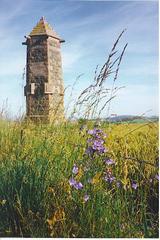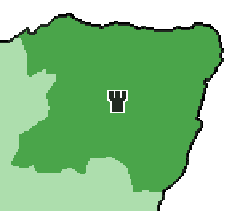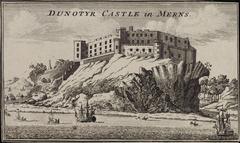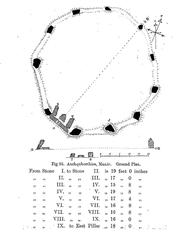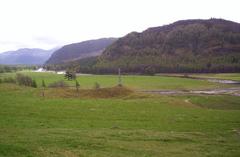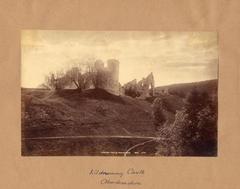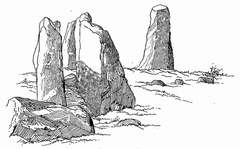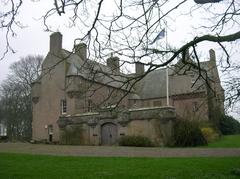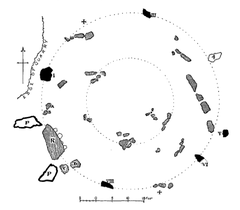Kirkton of Bourtie Stone Circle: Visiting Hours, Tickets, and Historical Significance in Aberdeenshire, United Kingdom
Date: 15/06/2025
Introduction
Kirkton of Bourtie Stone Circle stands as one of Aberdeenshire’s most evocative prehistoric monuments. Situated amid the rolling hills near Inverurie, Scotland, this recumbent stone circle offers visitors a remarkable glimpse into the ceremonial and astronomical traditions of late Neolithic and early Bronze Age communities. With its imposing recumbent stone, upright flankers, and panoramic views across the Garioch, Kirkton of Bourtie not only serves as a testament to ancient engineering but also as a focal point for cultural heritage in northeast Scotland.
This guide provides essential information for prospective visitors, including practical details on access, visiting hours, ticketing (admission is free), and accessibility. It also highlights the site’s historical context, nearby attractions, and responsible tourism practices to help you get the most from your visit.
Contents
- Introduction
- Historical Background and Typology
- Archaeological Investigations
- Cultural and Astronomical Significance
- Site Layout and Visitor Experience
- Visiting Hours, Tickets, and Accessibility
- Practical Tips and Responsible Visiting
- Nearby Attractions
- Frequently Asked Questions (FAQ)
- Summary and Further Information
- Visual Resources
- Sources and Further Reading
Historical Background and Typology
The Kirkton of Bourtie Stone Circle is a classic example of a recumbent stone circle, a monument type distinctive to northeast Scotland. These circles are characterized by a large horizontal “recumbent” stone set on the southwestern arc of the circle, flanked by two tall upright stones. The remaining circle is formed by additional upright granite stones, some of which have fallen or are missing due to the passage of time (Historic Environment Scotland).
Estimated to have been constructed between 2500 and 1500 BCE, the original circle likely comprised around 12 stones and measured approximately 18–21 meters in diameter (Spotting History; Aberdeenshire Council Archaeology Service). Today, eight stones remain upright, including the prominent recumbent and its flankers.
Archaeological Investigations
The site has attracted archaeological interest since the 19th century, with its first record in the 1867 Ordnance Survey Name Book for Aberdeenshire. F.R. Coles, H.A.W. Burl, Alexander Thom, and others have contributed to understanding its construction, alignment, and possible ceremonial uses. Detailed surveys suggest the recumbent stone—measuring up to 5 meters in length—is the longest of its kind in Scotland. The circle is protected as a Scheduled Ancient Monument, with ongoing oversight by Historic Environment Scotland (Canmore).
Within the circle, traces of a ring cairn—a low grassy mound—suggest funerary or ritual activity typical of recumbent stone circles. The alignment of the recumbent stone and flankers has been analyzed for potential lunar and solar astronomical purposes (Historic Environment Scotland).
Cultural and Astronomical Significance
Recumbent stone circles are unique to northeast Scotland and are believed to have served both ceremonial and astronomical functions. The southwest positioning of the recumbent stone may align with significant lunar events, such as the major southern moonset, or with sunset at midsummer (Burl, 1976). The circle’s elevated site with panoramic vistas would have enhanced its importance as a social and ritual gathering place.
Site Layout and Visitor Experience
Kirkton of Bourtie Stone Circle is set on a low knoll, offering commanding views of the surrounding farmland and distant hills, including the Bennachie range. The recumbent stone forms the focal point on the southwest arc, flanked by two large standing stones. The remaining uprights—composed of local granite and weathered by centuries of exposure—complete the circle’s rough perimeter. The site is enclosed by a low fence to protect it from livestock, but visitors can enter through a gate (Visit Aberdeenshire).
There are no interpretation panels or visitor facilities on site, so visitors are encouraged to research beforehand or use a guidebook or audio guide, such as those available through the Audiala app.
Visiting Hours, Tickets, and Accessibility
Visiting Hours:
The stone circle is open year-round, 24 hours a day. There are no official opening or closing times, but daylight hours are recommended for safety and to appreciate the landscape.
Tickets/Entry Fee:
Admission is free, and no tickets are required.
Accessibility:
Access involves a short walk over grassy, uneven terrain. There are no paved paths, so the route may be challenging for those with limited mobility or wheelchair users. Sturdy footwear is advised, and visitors should be prepared for variable Scottish weather.
Facilities:
There are no restrooms, shelters, or seating at the site. The nearest amenities are in Oldmeldrum or Inverurie.
Practical Tips and Responsible Visiting
- Respect the Monument: Do not climb on or move the stones; it is both illegal and damaging.
- Leave No Trace: Remove all litter and avoid graffiti or other markings.
- Stay on Paths: Stick to established field margins to protect the site and surrounding farmland.
- Respect Local Landowners: Close gates and avoid disturbing livestock.
- No Artifact Removal: Removing stones or artifacts is strictly prohibited.
- Photography: Personal photography is welcome; commercial use requires permission.
Nearby Attractions
While in the area, visitors can explore several other notable sites:
- Sheldon Stone Circle: Another well-preserved recumbent stone circle nearby.
- Hill of Barra: A popular hiking destination with panoramic views.
- Inverurie: Home to museums, restaurants, and additional heritage attractions.
For a broader exploration of Aberdeenshire’s prehistoric landscape, consider visiting Loanhead of Daviot, East Aquhorthies, and Cullerlie Stone Circles.
Frequently Asked Questions (FAQ)
Q: What are the visiting hours for Kirkton of Bourtie Stone Circle?
A: The site is open year-round, 24/7. Daylight hours are recommended.
Q: Is there an entrance fee or ticket required?
A: No, access is free and does not require tickets.
Q: Is the site wheelchair accessible?
A: No, the terrain is uneven with no paved paths, making it unsuitable for wheelchair users.
Q: Are guided tours available?
A: There are no official guided tours, but some local operators may offer prehistoric site tours including Kirkton of Bourtie.
Q: Can I climb on the stones or take souvenirs?
A: No. Climbing, moving stones, or removing artifacts is illegal and damages the site.
Q: Are there toilets or facilities on-site?
A: No, the nearest facilities are in Oldmeldrum or Inverurie.
Summary and Further Information
Kirkton of Bourtie Stone Circle is a fascinating and accessible example of Scotland’s prehistoric heritage. With free, year-round access and a tranquil rural setting, it is ideal for history enthusiasts, photographers, and those keen to immerse themselves in the ancient landscapes of Aberdeenshire. Visitors are encouraged to respect the monument, adhere to responsible tourism practices, and explore the surrounding area’s rich archaeological legacy.
For the latest visitor information, conservation updates, and related historical sites, consult official and authoritative sources:
Visual Resources
Sources and Further Reading
- Historic Environment Scotland – Kirkton of Bourtie Stone Circle Official Designation
- Spotting History: Kirkton of Bourtie Stone Circle
- Canmore Database Entry for Kirkton of Bourtie
- Live Breathe Scotland: Stone Circles in Aberdeenshire
- Aberdeenshire Council Archaeology Service – Stone Circles
